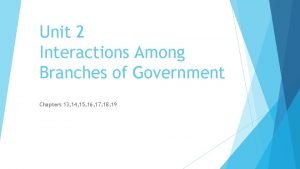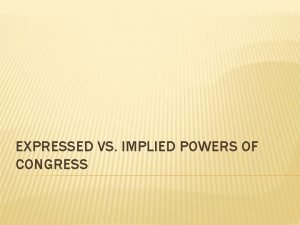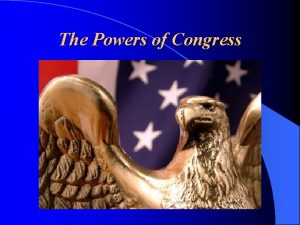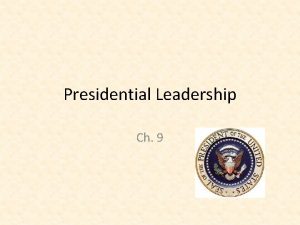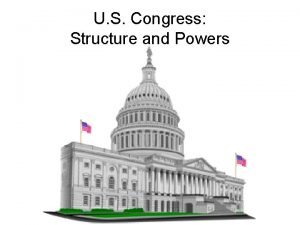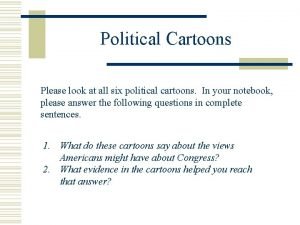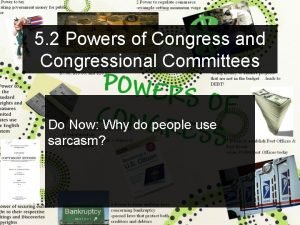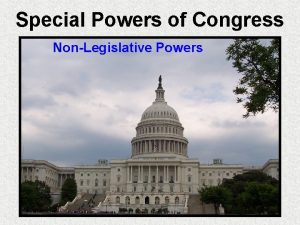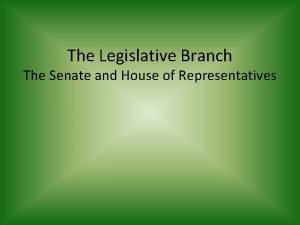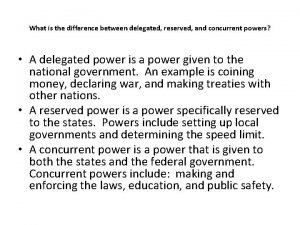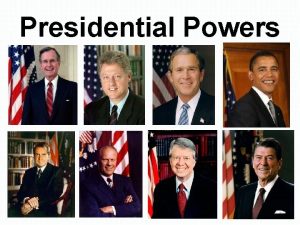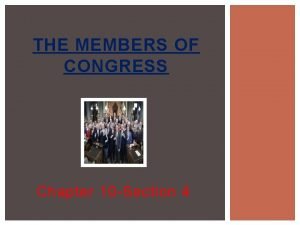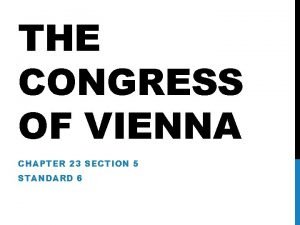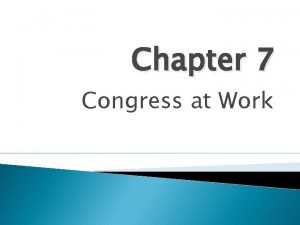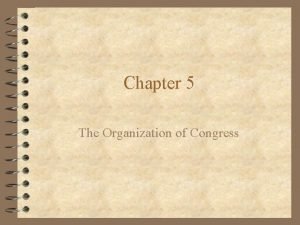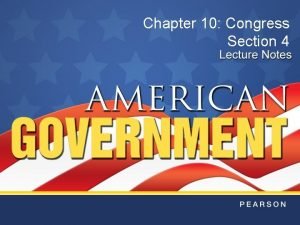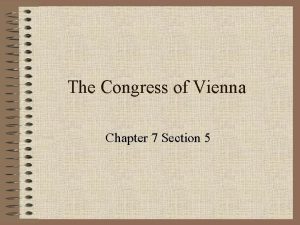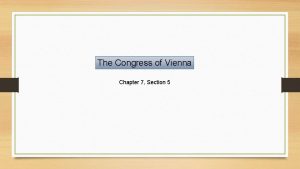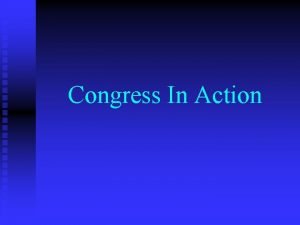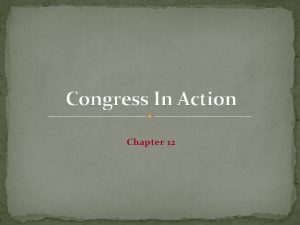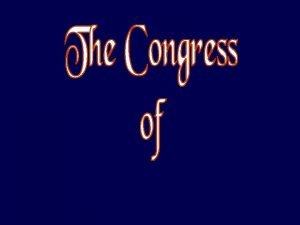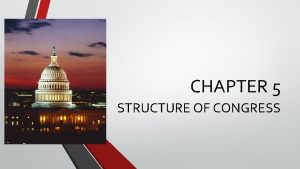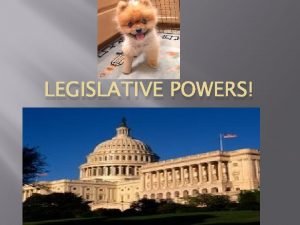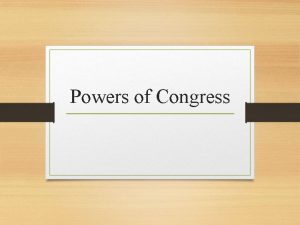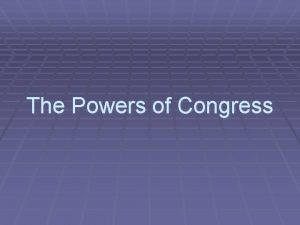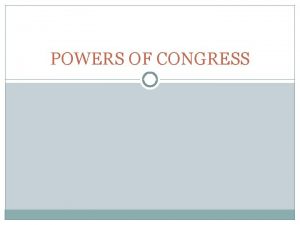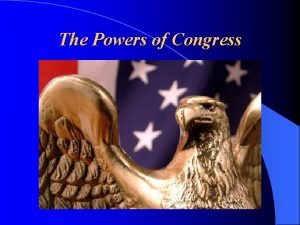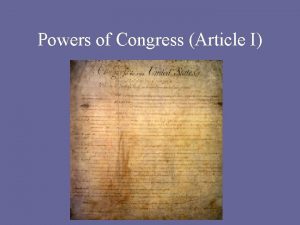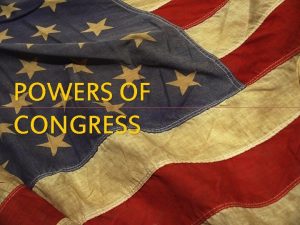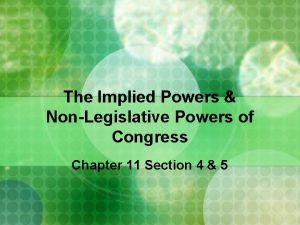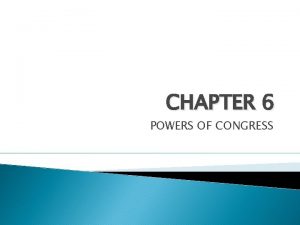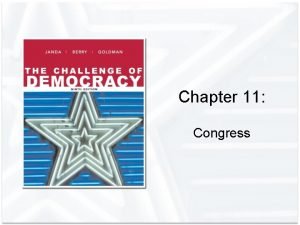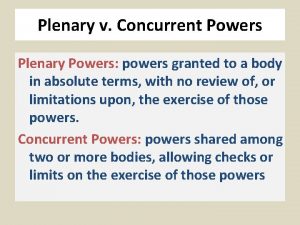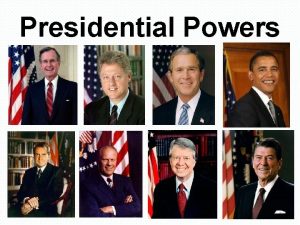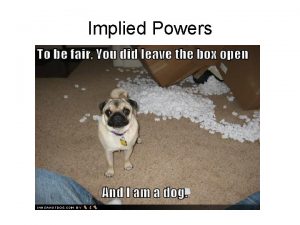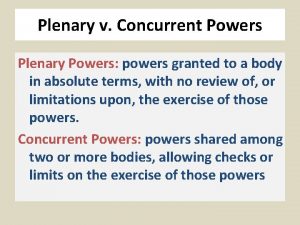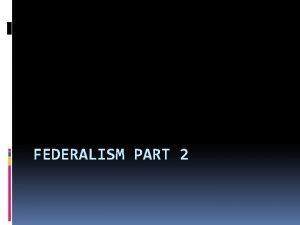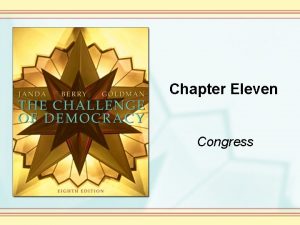Chapter 11 CONGRESS 2 The Origin and Powers
















































- Slides: 48

Chapter 11 CONGRESS

2

The Origin and Powers of Congress The Great Compromise created two separate, powerful legislative chambers Equal representation in Senate Proportional representation in House; House must initiate revenue-related legislation Identical bills must be passed by both chambers to become law 3

Representation Senators serve six-year terms; 1/3 are elected every two years Initially Senators selected by state legislatures; 17 th Amendment changed that process to direct elections All 435 Representatives stand for re-election every two years Census every 10 years leads to reapportionment and subsequent redistricting 4

Duties of the House and Senate Many shared powers House alone responsible for revenue bills and impeachment charges Senate alone responsible for approving treaties, presidential appointments, and trials on the articles of impeachment passed by the House 5

Electing Congressional elections give voters a chance to show approval or disapproval of Congress’s performance Incumbents usually re-elected despite the fact polls show public dissatisfaction with Congress’s actions 6

Figure 11. 1 Incumbents: Life is Good 7

Figure 11. 2 We Love Our Incumbents, But Congress Itself Stinks 8

Redistricting After each census, states must re-draw House districts Changing district lines for partisan advantage is gerrymandering Computer programs make gerrymandering easy to do Some argue that gerrymandering increases partisan polarization 9

Name Recognition Incumbency has advantages Name recognition because of press coverage of activities and speeches Franking privileges Twitter accounts Casework Campaign contributions 10

Campaign Financing Challengers must spend large sums of money to run campaigns Difficult to raise money Higher-quality challengers more likely to win, especially against vulnerable incumbents In 2008, incumbents raised 61 percent of all contributions to House and Senate Races Challengers received only 23 percent PACs prefer incumbents 11

Whom Do We Elect? Those elected not a cross-section of American society Most are upper-class professionals Around 44 percent are millionaires Women and minorities underrepresented Seventeen women currently serve in Senate 12

The Millionaire’s Club 13

Compared with What? Women in Legislatures 14

Descriptive Representation Some believe descriptive representation is lacking Voting Rights Act amendments in 1983 designed to encourage the drawing of minority districts Supreme Court ruling in Thornburg v. Gingles (1986) also pushed states to concentrate minorities in House districts to ensure better representation 15

Figure 11. 3 Minorities in Congress 16

Minorities in Congress Efforts to draw districts favorable to minorities being elected benefited African Americans, but not Hispanics Supreme Court’s ruling in Shaw v. Reno (1993) indicated racial gerrymandering might violate rights of whites Later rulings said race must not be “dominant and controlling factor” in drawing district boundaries 17

How Issues Get on the Congressional Agenda Formal legislative process starts with introducing a bill in the House or Senate Problem or issue must be identified first Many major issues constant; others appear suddenly Technology changes and/or highly visible events focus national attention on an issue Presidential or congressional support moves issues and related bills more rapidly 18

The Dance of Legislation: An Overview Process of bill-writing and passage follows specific steps (see Figure 11. 4) Process in House and Senate similar, but House requires bills to go to Rules Committee before going to the floor Complexity comes with the many ways a bill can be treated at each step 19

Figure 11. 4 The Legislative Process 20

Committees: The Workhorses of Congress Real work of Congressional policymaking happens in committees, which address specific policy areas Standing committees and their related subcommittees Joint committees Select committees Conference committees 21

Congressional Expertise and Scrutiny Influence in Congress increases with expertise and seniority Senior member of majority party usually committee chair Republican leadership policy limits committee and subcommittee chairs to six-year terms Democrats largely use seniority system 22

Committee Action First step in drafting legislation is information gathering Research by committee staff Public hearings by committees or subcommittees Actual debate and amendments on bills in committee happens during markup sessions Committee chairs need to build coalitions 23

The Committee Song and Dance 24

Oversight: Following Through on Legislation Once a bill becomes law, it is administered by a federal agency Congress has power of oversight to ensure bills enacted as intended However, magnitude of executive branch makes oversight difficult Several different types of oversight: hearings, reports, and informal contacts 25

Majoritarian and Pluralist Views of Committees Government by committee vests great power in committees, subcommittees, and their leaders In some ways, this enhances pluralism, since these people are elected Majoritarian aspect of committees comes through debates and compromises on bills necessary to get a bill passed 26

Leaders and Followers in Congress Party leaders in each house work to maximize influence of their party and ensure smooth and efficient functions Operation of each chamber based on rules and norms developed over the years 27

The Leadership Task in the House Majority party leadership : Speaker of the House Majority leader Majority whip Minority party leadership: Minority leader Minority whip Both parties have committees for fundraising, strategy development, and logistics assistance 28

The Leadership Task in the Senate Constitutionally, Vice President is president of the Senate However, president pro tem usually serves Real power in the Senate resides in majority leader Both majority and minority leader play critical role in getting bills through congress through bargaining and negotiations 29

Clyburn Takes the Whip 30

The Johnson Treatment 31

Rules of Procedure Rules in each chamber based on parliamentary procedure Rules not always the same in House and Senate Bill consideration in Senate requires 60 senators to vote for unanimous consent agreement One Senate rule allows filibusters, which can be limited by a vote for cloture House amendments must be germane; Senate’s do not House bills must go to House Rules Committee before floor debate 32

Norms of Behavior Some norms are set rules; others are unwritten Two most important norms: Show respect to colleagues, even bitter opponents Be willing to bargain with one another 33

The Legislative Environment Decisions about votes affected by political parties, the president, constituents, and interest groups Political parties and the president majoritarian influences on policymaking Constituents and interest groups are pluralist influences on policymaking 34

Political Parties strong force in legislative process by controlling: Committee appointments Consideration of a legislator’s bills or amendments Appointments to leadership positions Parties also showcase differences in ideologies Majoritarianism at work after 2008 election 35

Figure 11. 5 Rising Partisanship 36

The Presidents tend to act as though they are speaking for the majority Public expectations for the presidency grew in the 20 th century White House openly involved in crafting legislation However, Congress still in charge of legislation 37

Constituents The people in a legislator’s district or state crucial to decision-making process Legislators must consider what voters want Constituent influence contributes to pluralism because of the geographic basis of representation 38

Interest Groups Interest groups prime example of pluralist politics Legislators pay attention to interest groups because they represent voters Lobbyists also provide key information and contributions Access is the first step towards influence 39

The Dilemma of Representation What a legislator’s constituents want is not always what the majority in the nation want After working in Washington all week, legislators fly home to meet with constituents However, sometimes hard to act on knowledge gained from constituents 40

Constituents Strike Back 41

Trustees or Delegates? Must members of Congress vote the way their district prefers, even if it goes against their conscience or national interests? Trustees vote their conscience Delegates vote their district or state Opinions of constituents not always clear 42

Pluralism, Majoritarianism, and Democracy Voting as delegates supports pluralistic policymaking Majoritarian policymaking relies on involvement of political parties Voting as a trustee not necessarily majoritarian 43

Parliamentary Government In parliamentary system, chief executive is leader of party with a majority In Great Britain, voters only vote for their member of Parliament Voters influence policymaking by their party choice With multiple parties, sometimes must form ruling coalition 44

Parliamentary Government In this system, government power highly concentrated in legislature No separation of governmental power Usually have only one house, or a very weak second house Usually no court that can invalidate acts of parliament A very majoritarian form of government 45

Politics of Global Change: Creating a Legislature New Iraqi government based on proportional representation Each province has a multimember district Government is federal and has a unicameral legislature Representatives vote for presidential council, prime minister, and cabinet Disputes mean Iraqi parliament a work in progress 46

Pluralism Versus Majoritarianism in Congress U. S. Congress criticized for being too pluralist Despite public concern about deficit, legislators put earmarks in appropriations bills Democrats recently reformed earmark process for greater transparency Growing partisanship means greater majoritarianism So, modern Congress characterized by both pluralism and majoritarianism 47

Earmark Question Mark 48
 Chapter 11 powers of congress
Chapter 11 powers of congress Congress formal and informal powers
Congress formal and informal powers Presidential powers informal or implied powers
Presidential powers informal or implied powers President's formal and informal powers
President's formal and informal powers Describes structure and powers of congress
Describes structure and powers of congress Legislative vs non legislative powers
Legislative vs non legislative powers Central powers wwi
Central powers wwi Expressed vs implied powers of congress
Expressed vs implied powers of congress 4 powers of congress
4 powers of congress What are the informal sources of presidential power?
What are the informal sources of presidential power? Non legislative powers of congress
Non legislative powers of congress Inherent vs implied powers
Inherent vs implied powers Non legislative powers of congress
Non legislative powers of congress 4 powers of congress
4 powers of congress Congress informal powers
Congress informal powers Implied powers of congress
Implied powers of congress 4 powers of congress
4 powers of congress Powers of congress
Powers of congress Necessary and proper clause cartoon
Necessary and proper clause cartoon Powers of congress cartoon
Powers of congress cartoon 5 non legislative powers of congress
5 non legislative powers of congress Expressed vs enumerated powers
Expressed vs enumerated powers What are the powers of congress
What are the powers of congress Was the united states on the axis powers or allied powers?
Was the united states on the axis powers or allied powers? Difference between delegated reserved and concurrent powers
Difference between delegated reserved and concurrent powers Chapter 14 section 3 diplomatic and military powers
Chapter 14 section 3 diplomatic and military powers Chapter 1 consumer powers and protections
Chapter 1 consumer powers and protections Chapter 10 section 4 the members of congress
Chapter 10 section 4 the members of congress Chapter 23 section 5 the congress of vienna
Chapter 23 section 5 the congress of vienna Chapter 7 congress at work
Chapter 7 congress at work The organization of congress chapter 5
The organization of congress chapter 5 Chapter 23 section 5
Chapter 23 section 5 Chapter 10 section 4 the members of congress
Chapter 10 section 4 the members of congress The congress of vienna chapter 7 section 5
The congress of vienna chapter 7 section 5 The congress of vienna chapter 7 section 5
The congress of vienna chapter 7 section 5 Chapter 12 section 1 congress organizes
Chapter 12 section 1 congress organizes Chapter 12 section 1 congress organizes
Chapter 12 section 1 congress organizes Chapter 5 lesson 1 congressional membership
Chapter 5 lesson 1 congressional membership Chapter 23 section 5 the congress of vienna
Chapter 23 section 5 the congress of vienna Chapter 23 section 5 the congress of vienna
Chapter 23 section 5 the congress of vienna The organization of congress chapter 5
The organization of congress chapter 5 Hình ảnh bộ gõ cơ thể búng tay
Hình ảnh bộ gõ cơ thể búng tay Lp html
Lp html Bổ thể
Bổ thể Tỉ lệ cơ thể trẻ em
Tỉ lệ cơ thể trẻ em Voi kéo gỗ như thế nào
Voi kéo gỗ như thế nào Thang điểm glasgow
Thang điểm glasgow Hát lên người ơi alleluia
Hát lên người ơi alleluia Các môn thể thao bắt đầu bằng tiếng bóng
Các môn thể thao bắt đầu bằng tiếng bóng

